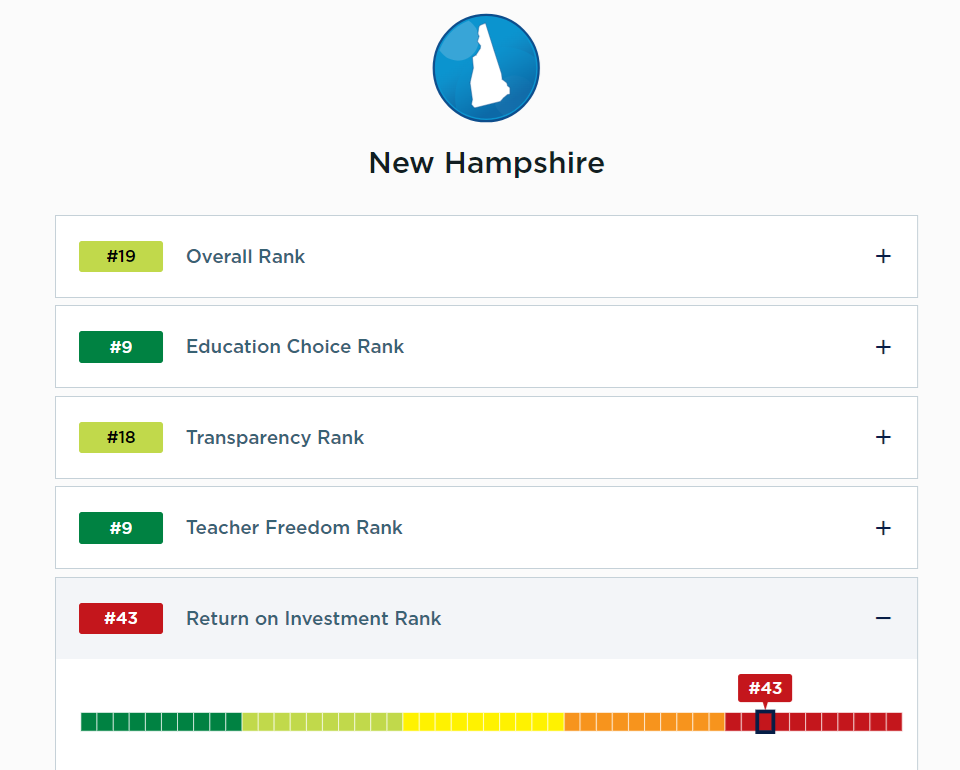Education Freedom, both the idea and its actual embrace, has seen significant growth in recent years—a result of policy choices by Democrats who hate it. COVID oppression locked kids down and out of schools for months or years – and parents with them putting Ed-Choice on the radar.
This is how it is, they said, to which more parents than ever replied, this is how it was – we’re done with that. The result has been a steady exodus from traditional government schools to charter schools, private schools (both affordable and not), home school collectives, and more of the traditional parent-child version people might picture when asked about it.
New Hampshire added Education Freedom Accounts, which recently survived a legal challenge and has had a number of education freedom options in place for years. Despite these improvements, the state ranked 18th on the Heritage Foundation’s recent Education Freedom Report Card. What killed them?
- New Hampshire ranks 43rd in return on investment (ROI) for education spending.
- New Hampshire spends the 10th-most per pupil among states, spending $18,442 in cost-of-living-adjusted terms annually.
- New Hampshire ranks fifth in its combined fourth-grade and eighth-grade math and reading average NAEP score.
- The Granite State employs 0.85 teachers for every non-teacher in its public schools.
- New Hampshire’s unfunded teacher pension liability represents 7.5 percent of its state GDP.
- New Hampshire can improve its ROI ranking by reducing per-pupil spending, stopping growth in non-teaching staff, and addressing its considerable unfunded teacher pension liabilities.
This will sound familiar—cost per student, results, and administrative overhead. And there is plenty of room for improvement. That said, we are in better shape – according to Heritage, than every other state in New England. While Maine is a disappointing 35th on their report card, Connecticut is 50th (Oregon was 51st), Rhode Island was 49th, Massachusetts ranked 47th, and Vermont 46th (New York was 48th).
We’ll look at Vermont because we like to pick on them and not just because we give a Grok about the state; it dropped 22 spots in one year.
Vermont ranks #46 in overall education freedom in 2023, dropping 22 spots, the largest one-year decline in the country. Vermont declined in every category, most notably a nation’s-worst 39 spots in transparency.
Ouch.
Vermont ranks 50th overall in return on investment (ROI) for education spending. Vermont spends the third-most per pupil among states, spending $22,281 in cost-of-living-adjusted terms annually. Vermont ranks 20th in its combined fourth-grade and eighth-grade math and reading average NAEP score. The Green Mountain State employs 0.75 teachers for every non-teacher in its public schools. Vermont’s unfunded teacher pension liability represents 10.1 percent of its state GDP. Vermont can improve its ROI ranking by lowering per-pupil spending, improving academic outcomes on the NAEP, stopping growth in non-teaching staff, and addressing its significant unfunded teacher pension liabilities.
Everything wrong with NH’s return on investment is worse west of the Connecticut River, and – a wake-up call – NH Dems want that for the Granite State. They are surrounded by bad examples, which they see as things for which they should strive, to hell with parents and students.
And Vermont? They want to be like Connecticut or maybe even Oregon.

